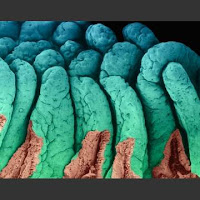Structure and function of the gastrointestinal (GI) system
1. Describe the GI system.
Answer: The GI system runs from the mouth to the anus and is responsible for the digestion of food and the excretion of waste products.
2. What are the four main regions of the GI tract between mouth and anus?
Answer: oesophagus; stomach; large intestine; small intestine.
3. Name four organs/structures that are linked to the GI tract.
Answer: liver; pancreas; gall bladder; appendix.
4. Describe the peritoneum and what is the space that it encloses called?
Answer: transparent membrane; lines the abdominal cavity; carries nerves and blood vessels to viscera; peritoneal cavity.
5. What kind of muscle is found in the GI tract, how is it arranged and how is it controlled?
Answer: smooth muscle; longitudinal and circular; autonomic nervous system.
6. What is the process that moves food along the GI tract? Describe this process.
Answer: peristalsis: waves of contraction and relaxation of smooth muscle which propel food along the GI tract.
7. What is the space in the GI tract called and what is the lining of the GI tract called? What are the two functions of the lining?
Answer: lumen; mucosa. Secretory and absorbtive.
8. Name the three pairs of salivary glands. What is the MAIN function of saliva?
Answer: parotid; sumandibular; sublingual. Lubrication of food.
9. What is mastication? In addition to saliva what other parts of the mouth are involved? What is the end product of mastication?
Answer: chewing. Tongue & teeth. Bolus of food.
10. What are the muscles of mastication? Which joint is involved and what is unique about it?
Answer: masseter & temporalis. Temperomandibular joint; allows movement in three planes.
11. In the process of swallowing, which tube does the bolus of food enter on its way to the stomach? Which tube is protected by the epiglottis and what is the epiglottis? How is the bolus of food moved to the stomach?
Answer: the oesophagus. The trachea. a flap of cartilage. Peristalsis.
12. What are the functions of the stomach?
ANSWER: it acts as a reservoir; it completes the mechanical breakdown of food; it secretes hydrochoric acid; it produced chyme.
13. What are the three muscle layers of the stomach and what are the convolutions on the inner surface of the stomach called?
ANSWER: circular; longitinal; oblique; rugae.
14. In addition to gastrin and intrinsic factor what other three things are produced by the gastric pits and what is setreted by the gastric pits?
ANSWER: mucous; hydrochloric acid; pepsin. Parietal cells produce hydrochloric acid.
15. State the three regions of the small intestine in the correct order.
ANSWER: duodenum; jejunum; ileum.
16. What are the functions of the small intestine?
ANSWER: it mixes food by segmentation; it propels food by persitalsis; it secretes digestive enzymes and mucous; it absorbs nutrients.
17. What features of the lining of the small intestine provide it with a large surface area? What are the three groups of enzymes (ie in terms of what they digest) that are secreted into the small intestine?
ANSWER: villi; protein digesing, carbohydrate digesting, fat digesting enzymes.
18. Where do pancreatic secretions enter the duodenum? In addition to sodium bicarbonate what digestive enzymes are produced by the pancreas?
ANSWER: the ampulla of Vater; trypsin, amylase and lipase.
19. Where is bile made? What does the gall bladder do? Where is bile released into the duodenum? What does bile do?
ANSWER: liver; stores and concentrates bile; ampulla of Vater; emulsifying agent.
20. Describe digestion.
ANSWER: a process of breaking large molecules into smaller ones which can be absorbed from the intestine and used in metabolism.
21. What do enzymes do? What are the three phases of digestion?
ANSWER: they act as catalysts for biological reactions; cephalic, gastric, intestinal.
22. What are the three phases of digestion - in the correct order?
ANSWER: cephalic; gastric; intestinal.
23. What is mainly reabsorbed in the large intestine and what are the three major regions of the large intestine?
24. What are the three types of movement in the large intestine and which bacterium is mainly found here?
ANSWER: peristalsis; haustral churning; mass movement. E coli.
25. Describe the structure and function of the internal and external anal sphincters.
ANSWER: internal - smooth muscle and involuntary; external - skeletal muscle and voluntary.

























ReplyDeleteAs a sign of gratitude for how my wife was saved from PCOS & Gastro Disorder, I decided to reach out to those still suffering from this.
My wife suffered pcos in the year 2013 and it was really tough and heartbreaking for me because she was my everything and the symptoms were terrible, she always complained of heavy menstruation, and she always had difficulty falling asleep . We tried various therapies prescribed by our neurologist but none could cure her. I searched for a cure and I saw a testimony by someone who was cured and so many others with similar body problems, and they left the contact of this doctor who has the cure to pcos . I never imagined polycystic ovary syndrome. has a natural cure not until i contacted him and he assured me my wife will be fine. I got the herbal medication he recommended and my wife used it and in one months time she was fully okay even up till this moment she is so full of life. polycystic ovary syndrome. has a cure and he has herbal cure for Herpes,HIV/Aids,Diabetes,Neuro Disease,Cancer,Back Pain,COPD,Parkinson, and other disease you can visit Dr Itua herbal center website to read more www.drituaherbalcenter.com or email drituaherbalcenter@gmail.com on how to get the medication. Thanks admin for such an informative blog.